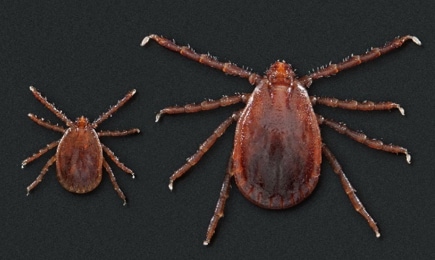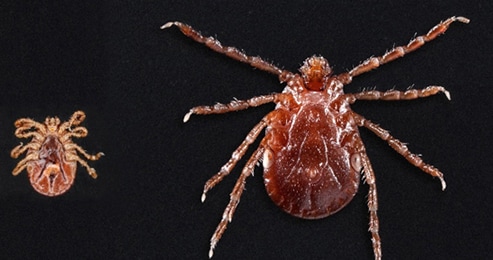What you need to know about Asian longhorned ticks
Centers for Disease Control
What do Asian longhorned ticks look like?
 |
| Nymph and adult female, top view. |
 |
| Nymph and adult female, underside. |
What we know about Asian longhorned ticks in the U.S.
Many species of ticks live in the United States. Each tick species
can carry and spread different types of germs.
When a scientist
discovers a new germ in a tick, studies are needed to determine if the tick can
carry and spread germs to a person or animal. Scientists need to determine:
- Can the germ survive and multiply in the tick?
- Can (enough) germs be passed through a tick bite
to cause an infection?
- Not normally found in the Western Hemisphere,
these ticks were reported for the first time in the United States in 2017.
- Asian longhorned ticks have been found on pets,
livestock, wildlife, and people.
- The female ticks can lay eggs and reproduce
without mating.
- Thousands of ticks may be found at a time in
grass or shrubs or on an animal.
- Researchers are looking for these ticks to find
out where they live and if they prefer wooded or more open areas.
- As of April 13, 2023, longhorned ticks have been
found in Arkansas, Connecticut, Delaware, Georgia, Indiana, Kentucky,
Maryland, Massachusetts, Missouri, New Jersey, New York, North Carolina,
Ohio, Pennsylvania, Rhode Island, South Carolina, Tennessee, Virginia, and
West Virginia.
- Compared with well-known native ticks (such as
the blacklegged tick, lone star tick and American dog tick), the Asian
longhorned tick appears to be less attracted to human skin.
- In other countries, germs spread via bites from
these ticks can make people and animals seriously ill.
- With ongoing testing of ticks collected in the
United States, it is likely that some ticks will be found to contain
germs that can be harmful to people. However, we do not yet know if and
how often these ticks are able to pass these germs along to people and
make them ill. (See sidebar.)
- One recent experimental study found that this
tick is not likely to contribute to the spread of Lyme disease bacteria
in the United States.
- Another laboratory study found that this tick
has the ability to carry and spread the bacteria that causes Rocky
Mountain spotted fever (Rickettsia
rickettsii). The germs that cause Rocky Mountain spotted fever have
not yet been found in these ticks in nature.
- Research is ongoing.
- You can protect yourself from tick
bites. CDC-recommended personal protective measures such
as the use of EPA-approved insect repellents and 0.5% permethrin-treated
clothing are effective against Asian longhorned ticks.
What
you should do if you think you have found an Asian longhorned tick
- Remove ticks
from people and animals as quickly as possible.
- Save the ticks in rubbing alcohol in a jar or a
ziplock bag, then:
- Contact your health department about steps you can take to prevent tick bites and
tickborne diseases.
- Contact a veterinarian for information about
how to protect pets from ticks and tick bites.
- Contact your state agriculture department or
local agricultural extension office about ticks on livestock or for tick
identification.
Videos
Asian longhorned tick videos fAdditional Resources
USDA National Haemaphysalis
longicornis (Asian
longhorned tick) Situation Report
Beard CB, Occi J,
Bonilla DL, et al. Multistate infestation with the
exotic disease-vector tick Haemaphysalis
longicornis – United States, August 2017-September 2018. MMWR Morb Mortal Wkly Rep. 2018 Nov
30;67(47):1310-1313.
Breuner NE, Ford SL,
Hojgaard A, et al. Failure of the Asian longhorned tick, Haemaphysalis longicornis, to serve as an
experimental vector of the Lyme disease spirochete, Borrelia
burgdorferi sensu stricto.
Foster E, Fleshman AC,
Ford SL, et al. Preliminary evaluation of human personal protective
measures against the nymphal stage of the Asian longhorned tick (Acari:
Ixodidae)
Pritt BS. Haemaphysalis longicornis is in the United States and
biting humans: Where do we go from here?
Rainey T, Occi JL,
Robbins RG, Egizi A. Discovery of Haemaphysalis
longicornis (Ixodida: Ixodidae) parasitizing a sheep in New Jersey,
United States
Stanley HM, Ford SL,
Snellgrove AN, et al. The ability of the invasive Asian longhorned tick, Haemaphysalis longicornis (Acari:
Ixodidae) to acquire and transmit Rickettsia
rickettsii (Rickettsiales: Rickettsiaceae), the agent of Rocky
Mountain spotted fever, under laboratory conditions.
Tufts DM, VanAcker MC,
Fernandez MP, et al. Distribution, host-seeking phenology, and host and habitat associations
of Haemaphysalis longicornis ticks,
Staten Island, New York, USA. Emerg
Infect Dis. 2019 Apr;25(4):792-796.
Wormser GP, McKenna D,
Piedmonte N, et al. First recognized human Bite in the United States by
the Asian longhorned tick, Haemaphysalis
longicornis